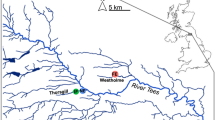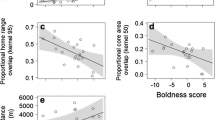Abstract
Intraspecific differences in the dispersal propensity of animals have been linked to interindividual variation in inherent tendencies (i.e., personality or behavioral type) that influence multiple aspects of an individual’s behavior. Studies linking dispersal propensity and personality often (1) focus on defining behavioral tendencies with a single behavioral trait rather than multiple, (2) do not recognize that invertebrates may have behavioral tendencies that influence dispersal, and (3) do not consider how the behavioral type of other individuals affects the dispersal propensity of an individual. We documented multiple foraging behaviors of an aquatic predatory insect (Notonecta irrorata) and found that Notonecta individuals differ in their inherent behavioral tendency (i.e., degree of boldness); all foraging behaviors were correlated such that riskier behaviors were exhibited by the same individuals. We conducted an experiment in which we varied which behavioral types of Notonecta were placed in outdoor pools (passive, bold or both types present) and quantified how long it took for individuals to disperse. Passive and bold individuals had a similar propensity to disperse but the dispersal propensity of each behavioral type was influenced by the behavioral type of other conspecifics present in the pool. Our work reveals that (1) invertebrates have inherent behavioral tendencies that vary among individuals but these tendencies do not necessarily impact all of the behavior displayed by the individual (i.e., impact foraging but not dispersal) and (2) the inherent behavioral tendency of other individuals with which an animal co-occurs can affect habitat patch dynamics such as predation, competition, or colonization.


Similar content being viewed by others
References
Aguillon S, Duckworth R (2015) Kin aggression and resource availability influence phenotype-dependent dispersal in a passerine bird. Behav Ecol Sociobiol 69:625–633
Baines C, McCauley S, Rowe L (2014) The interactive effects of competition and predation risk on dispersal in an insect. Biol Lett 10:20140287
Baines C, McCauley S, Rowe L (2015) Dispersal depends on body condition and predation risk in the semi-aquatic insect, Notonecta undulata. Ecol Evol 12:2307–2316
Blumstein D, Daniel J (2007) Quantifying behavior the JWatcher way. Sinauer Associates Inc., Sunderland
Bolnick DI, Amarasekare P, Araújo MS, Bürger R, Levine JM, Novak M, Rudolf VH, Schreiber SJ, Urban MC, Vasseur DA (2011) Why intraspecific trait variation matters in community ecology. Trends Ecol Evol 26:183–192
Bowler D, Benton T (2005) Causes and consequences of animal dispersal strategies: relating individual behaviour to spatial dynamics. Biol Rev 80:205–225
Camp M, Rachlow J, Woods B, Johnson T, Shipley L (2012) When to run and when to hide: the influence of concealment, visibility, and proximity to refugia on perceptions of risk. Ethology 118:1010–1017
Charnov EL (1976) Optimal foraging, the marginal value theorem. Theor Popul Biol 9:129–136
Colwell RK, Naeem S (1999) Sexual sorting in hummingbird flower mites (Mesostigmata: Ascidae). Ann Entomol Soc Am 92:952–959
Cook W, Streams F (1984) Fish predation on Notonecta (Hemiptera): relationship between prey risk and habitat utilization. Oecologia 64:177–183
Cooper E, Taylor R, Kelley A et al (2017) Personality is correlated with natal dispersal in North American red squirrels (Tamiasciurus hudsonicus). Behaviour 154:939–961
Cote J, Clobert J, Brodin T, Fogarty S, Sih A (2010a) Personality-dependent dispersal: characterization, ontogeny and consequences for spatially structured populations. Phil Trans R Soc B 365:4065–4076
Cote J, Fogarty S, Weinersmith K, Brodin T, Sih A (2010b) Personality traits and dispersal tendency in the invasive mosquitofish (Gambusia affinis). Proc R Soc B 277:1571–1579
Cote J, Fogarty S, Tymen B, Sih A, Brodin T (2013) Personality-dependent dispersal cancelled under predation risk. Proc R Soc B 280:1773
Cote J, Brodin T, Fogarty S, Sih A (2017) Non-random dispersal mediates invader impacts on the invertebrate community. J Anim Ecol 86:1298–1307
Crews D (2013) Animal personalities: behavior, physiology, and evolution. Claudio Carere and Dario Maestripieri, editors. Integr Comp Biol 53:873–875
Davenport J, Chalcraft D (2013) Nonconsumptive effects in a multiple predator system reduce the foraging efficiency of a keystone predator. Ecol Evol 3:3063–3072
Davenport J, Chalcraft D (2014) Increasing conspecific density weakens the ability of intermediate predators to develop induced morphological defenses to top predators. Freshw Biol 59:87–99
Debeffe L, Morellet N, Bonnot N et al (2014) The link between behavioural type and natal dispersal propensity reveals a dispersal syndrome in a large herbivore. Proc R Soc B 281:1790
Doligez B, Gustafsson L, Part T (2009) ‘Heritability’ of dispersal propensity in a patchy population. Proc Roy Soc B 276:1668
Fraser D, Gilliam J, Daley M, Le AN, Skalski G (2001) Explaining leptokurtic movement distributions: intrapopulation variation in boldness and exploration. Am Nat 158:124–135
Gade GL, Auerswald R, Predel H Marco (2004) Substrate usage and its regulation during flight and swimming in the backswimmer, Notonecta glauca. Physiol Entomol 29:84–93
Gaines M, McClenaghan L Jr (1980) Dispersal in small mammals. Ann Rev Ecol Syst 11:163–196
Hamilton WD, May RM (1977) Dispersal in stable habitats. Nature 269:578–581
Hovestadt T, Poethke HJ (2006) The control of emigration and its consequences for the survival of populations. Ecol Modell 190:443–453
Hurlbert S, Lombardi C (2012) Lopsided reasoning on lopsided tests and multiple comparisons. Aust NZ J Stat 54:23–42
Kats L, Dill L (1998) The scent of death: chemosensory assessment of predation risk by prey animals. Ecoscience 5:361–394
Kortet R, Hedrick A, Vainikka A (2010) Parasitism, predation and the evolution of animal personalities. Ecol Lett 13:1449–1458
Kralj- Fišer S, Schuett W (2014) Studying personality variation in invertebrates: why bother? Anim Behav 91:41–52
Lawrence WS (1988) Movement ecology of the red milkweed beetle in relation to population size and structure. J Anim Ecol 54:21–35
Lima S, Bednekoff P (1999) Temporal variation in danger drives antipredator behavior: the predation risk allocation hypothesis. Am Nat 153:649–659
Martin J, Lopez P (2004) Balancing predation risk, social interference, and foraging opportunities in backswimmers, Notonecta maculate. Acta Ethol 6:59–63
McCauley S, Rowe L (2010) Notonecta exhibit threat-sensitive, predator-induced dispersal. Biol Lett 6:449–452
McCauley S, Brodin T, Hammond J (2010) Foraging rates of larval dragonfly colonists are positively related to habitat isolation: results from a landscape-level experiment. Am Nat 175:66–73
Modlmeier A, Keiser CN, Wright CM, Lichenstein JLL, Pruitt JN (2015) Integrating animal personality into insect population and community ecology. Curr Opin Insect Sci 9:77–85
Myers J, Krebs C (1971) Genetic, behavioral, and reproductive attributes of dispersing field voles Microtus pennsylvanicus and Microtus ochrogaster. Ecol Monogr 41:53–78
Peakall R, Ruibal M, Lindenmayer D (2007) Spatial autocorrelation analysis offers new insight into gene flow in the Australian bush rat, Rattus fuscipes. Evolution 57:1182–1195
Relyea R (2001) Morphological and behavioral plasticity of larval anurans in response to different predators. Ecology 82:523–540
Relyea R (2004) Fine-tuned phenotypes: tadpole plasticity under 16 combinations of predators and competitors. Ecology 85:172–179
Royauté R, Pruitt J (2016) Varying predator personalities generates contrasting prey communities in an agroecosystem. Ecology 96:2902–2911
Ruehl C, Vance-Chalcraft H, Chalcraft D (2018) Co-occurence of prey species alters the impact of predators on prey performance through multiple mechanisms. Ecol Evol 8:8897–8907
SAS (2013) SAS version 9.4. SAS Institute Inc, Cary
Schaalje GB, McBride JB, Fellingham GW (2001) Approximations to distributions of test statistics in complex mixed linear models using SAS Proc MIXED. SUGI (SAS User’s Group Int) 26(262):1–5
Schneider C, Dover J, Fry G (2003) Movement of two grassland butterflies in the same habitat network: the role of adult resources and size of the study area. Ecol Entomol 28:219–227
Sih A, Watters J (2005) The mix matters: behavioral types and group dynamics in water striders. Behaviour 142:1417–1431
Sih A, Bell A, Johnson JC, Ziemba RE (2003) Behavioral syndromes: an integrative overview. Q Rev Biol 79:241–277
Sih A, Cote J, Evans M, Fogarty S, Pruitt J (2012) Ecological implications of behavioral syndromes. Ecol Lett 15:278–289
Smith B, Blumstein D (2008) Fitness consequences of personality: a meta-analysis. Behav Ecol 19:448–455
Spiegel O, Leu ST, Bull CM, Sih A (2017) What’s your move? Movement as a link between personality and spatial dynamics in animal populations. Ecol Lett 20:3–18
Start D, Gilbert B (2017) Predator personality structures prey communities and trophic cascades. Ecol Lett 20:366–374
Streams F (1987) Foraging behavior in a notonectid assemblage. Am Midl Nat 117:353–361
Stroup Walter W, Milliken George A, Claassen Elizabeth A, Wolfinger Russell D (2018) SAS® for mixed models: introduction and basic applications. SAS Institute Inc., Cary
Toscano B, Griffen B (2014) Trait-mediated functional responses: predator behavioural type mediates prey consumption. Anim Ecol 83:1469–1477
Travis J, Dytham C (2002) Dispersal evolution during invasions. Evol Ecol Res 4:1119–1129
Van Vuren D, Armitage K (1994) Survival of dispersing and philopatric yellow-bellied marmots: what is the cost of dispersal? Oikos 69:179–181
Wey T, Spiegel O, Montiglio P, Mabry K (2015) Natal dispersal in a social landscape: considering individual behavioral phenotypes and social environment in dispersal ecology. Curr Zool 61:543–556
Wolf M, Sander van Doorn G, Leimar O, Weissing FJ (2007) Life-history trade-offs favour the evolution of animal personalities. Nature 447:581–584
Yoder JM, Marschall EA, Swanson DA (2004) The cost of dispersal: predation as a function of movement and site familiarity in ruffed grouse. Behav Ecol 15:469–476
Acknowledgements
We would like to thank AJK’s thesis committee, Drs. Susan McRae and Heather Vance-Chalcraft, for valuable comments that improved this study. We also thank Samantha Kitchen, née Parrish, for helping with collection of organisms, set up of experiments, and comments.
Author information
Authors and Affiliations
Contributions
AJK and DRC conceived and designed the study, AJK conducted the experiments, AJK and DRC analysed the data, AJK and DRC wrote the manuscript.
Corresponding author
Additional information
Communicated by Jill Lancaster.
Electronic supplementary material
Below is the link to the electronic supplementary material.
Rights and permissions
About this article
Cite this article
Kitchen, A.J., Chalcraft, D.R. An individual’s propensity to disperse is dependent on the behavioral type of its peers but not its own behavioral type. Oecologia 194, 403–413 (2020). https://doi.org/10.1007/s00442-020-04769-8
Received:
Accepted:
Published:
Issue Date:
DOI: https://doi.org/10.1007/s00442-020-04769-8




